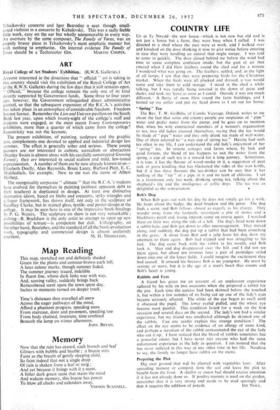ART
Royal College of Art Students' Exhibition; (R.W.S. Galleries.) ANYONE interested in the directions that " official " art is taking in this country should visit the exhibition of the Royal College of Art at the R.W.S. Galleries during the few days that it still remains open. - Official," because the college remains the only one of its kind directly supported by Government funds. Some three to four years ago, however, the Government relinquished direct administrative control, so that the subsequent expansion of the R.C.A.'s activities has taken place in an atmosphere of considerable freedom. Freedom but not licence. Remember the Lion and Unicorn pavilion on the South Bank last year, upon which twenty-eight of the college's staff and students were engaged, or the most recent Young Contemporaries exhibition, more than a quarter of which came from the college? Eccentricity was not the keynote.
The present exhibition, of painting, sculpture and the graphic arts, complements one devoted to applied and industrial design last summer. The effect is generally sober and serious. These young painters are not interested in cubism, surrealism or abstraction (Stanley Swain is almost alone with his carefully constructed Growing Forms); they are interested in social realism and mild, low-toned expressionism. A number of them are by now already known to us— Elizabeth Doelly, Alan Reynolds, Bruce Lacey, Richard Platt, E. C. Middleditch, for example. New to me was the name of Albert Herbert.
The recognisably corporate " climate " that the R.C.A. 's students have evolved for themselves in painting (without apparent debt to their teachers) is duplicated in design. At least one distinctive decorative idiom, based on blobs and crescents, spiky triangles and a linear framework, has shown itself, not only in the sculpture of Geoffrey Clarke, but in stained glass, textile- and poster-design at the college. It may be seen here in one of the impressive book-bindings by P. G. Waters. The sculpture on show is not very remarkable ; etching—B. Bradshaw is the only artist to attempt to open up new possibilities of texture—is competent but dull. Lithography, on the other hand, flourishes, and the standard of all the book-production work, typography. and commercial design is almost uniformly


























 Previous page
Previous page